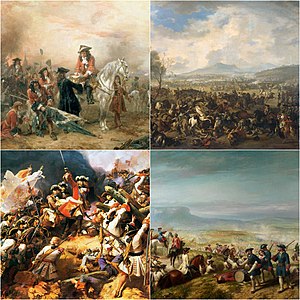The War of the Spanish Succession was a European great power conflict fought between 1701 and 1714. The immediate cause was the death of the childless Charles II of Spain in November 1700, which led to a struggle for control of the Spanish Empire between supporters of the French Bourbons and the Habsburgs. Charles named his heir as Philip of Anjou, a grandson of Louis XIV of France, whose claim was backed by France and most of Spain. His rival, Archduke Charles of Austria, was supported by the Grand Alliance, whose primary members included Austria, the Dutch Republic, and Great Britain. Significant related conflicts include the 1700 to 1721 Great Northern War, and Queen Anne's War.
Although by 1701 Spain was no longer the predominant European power, its global empire still included the Spanish Netherlands, large parts of Italy, and the Americas. Its acquisition by either France or Austria threatened the European balance of power, and Philip's proclamation as king of Spain on 16 November 1700 led to war. The French held the advantage in the early stages but were forced onto the defensive after 1706. Although the Allies continued to advance in northern France, by 1709 Philip had cemented his position in Spain, the ostensible cause of the war.
When Emperor Joseph I died in 1711, Archduke Charles succeeded his brother as Holy Roman Emperor. Since a union of Spain and Austria was as unwelcome as one with France, the new British government argued it was pointless to continue. By now, only British subsidies kept their allies in the war, and their withdrawal led to the Peace of Utrecht in 1713, followed by the treaties of Rastatt and Baden in 1714.
Philip was confirmed as king of Spain but renounced his claim and those of his descendants to the French throne. The Spanish Empire ceded much of its Italian territories to Savoy and Austria, along with the Spanish Netherlands, although it remained largely intact outside Europe. Britain received Gibraltar and Menorca and acquired major trade concessions in the Spanish Americas. For the Dutch, despite attaining their long sought-after Barrier Treaty, the war is seen as marking the beginning of their decline as a significant European power. Although Louis succeeded in placing his grandson on the Spanish throne, France was left financially exhausted.
- ^ Dwyer 2014, p. 14.
- ^ Lynn 1994, p. 894.
- ^ Vault 2016, pp. 98, 540, 625.
- ^ Vault 2016, p. 454.
- ^ Wilson 2016, p. 461.
- ^ Wilson 2016, p. 460.
- ^ Glete 2001, p. 156.
- ^ Ostwald 2000, p. 664.
- ^ Rasler 1994, p. 129.
- ^ Craig 1964, p. 7.
- ^ Wijn 1956, p. 509.
- ^ a b c d Clodfelter 2008, p. 74.
- ^ Urlanis 1971, p. 187.
- ^ Levy 2014, p. 90.
Cite error: There are <ref group=lower-alpha> tags or {{efn}} templates on this page, but the references will not show without a {{reflist|group=lower-alpha}} template or {{notelist}} template (see the help page).
